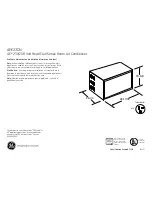
284809-YIM-B-0707
50
Unitary Products Group
FLASH CODES
The UCB will initiate a flash code associated with
errors within the system. Refer to UNIT CONTROL
BOARD FLASH CODES Table 27.
RESET
Remove the call for heating by lowering the thermostat
setting lower than the conditioned space temperature.
This resets any flash codes.
HEAT ANTICIPATOR SETPOINTS
It is important that the anticipator setpoint be correct.
Too high of a setting will result in longer heat cycles and
a greater temperature swing in the conditioned space.
Reducing the value below the correct setpoint will give
shorter "ON" cycles and may result in the lowering of the
temperature within the conditioned space. Refer to
Table 23 for the required heat anticipator setting.
GAS HEATING SEQUENCE OF OPERATIONS
The following sequence describes the operation of the
gas heat section.
When the thermostat calls for the first stage of heating,
the low-voltage control circuit from "R" to "W1" and "G"
is completed, thru the UCB. The heat relay "RW1" is
energized. The "RW1-2" contacts close energizing the
draft motor control. The draft motor control contacts
close and start the draft motor. As the speed of the
draft motor reaches approximately 2500 RPM, the cen-
trifugal switch contact, located on the end of the draft
motor shaft, closes to power the first stage ignition
module "IC1", thru the "RW1-1 contacts.
Ignition module "IC1" will immediately start the first
stage igniter sparking and will open the redundant
valve located inside the first stage main gas valve
"GV1" to allow a flow of gas to only the first stage carry-
over tube. Only after the pilot flame has been ignited
and the presence of pilot flame detected at the "IC1" by
a signal sent back through the flame sensor is sparking
terminated and the first stage main gas valve opened.
Gas flows into each of the main burners and is ignited
from the carryover tube flame.
After completing the specified fan on delay for heating,
the UCB will energize the blower motor.
If "IC1" fails to detect a pilot flame, it will continue to try
for a maximum of 85 seconds to ignite the pilot tube. If
the pilot flame is not detected, then "IC1" will lock out
first stage furnace operation for five minutes or until
24V power is removed from the module either at the
unit or by resetting the room thermostat.
When the thermostat calls for the second stage of
heating, the low-voltage control circuit from "R" to "W2"
is completed, thru the UCB. Heat relay "RW2" is ener-
TABLE 22: LIMIT CONTROL SETTING
TABLE 23: ELECTRIC HEAT ANTICIPATOR
SETPOINTS
HEATER
KW
VOLTAGE
SETTING, AMPS
TH1
TH2
18
208/230-3-60
0.29
-
36
0.29
0.29
54
0.29
0.58
72
0.29
0.58
18
460-3-60
0.29
-
36
0.29
0.29
54
0.29
0.29
72
0.29
0.29
18
575-3-60
0.29
-
36
0.29
0.29
54
0.29
0.29
72
0.29
0.29
18
36
54
72
18
36
54
72
18
36
54
72
18
36
54
72
TEMPERATURE LIMIT
SWITCH 1, 2
OPENS,
0
F
TEMPERATURE LIMIT
SWITCH 3, 4, 5, 6
OPENS,
0
F
UNIT
(Tons)
VOLTAGE
HEATER
kW
120
170
120
170
120
170
120
170
140
200
140
200
140
200
140
200
120
120
120
120
120
120
120
120
170
170
170
170
~
~
~
~
15
17.5, 20,
25
15,17.5,
20, 25
240
240
460
600
15,17.5,
20, 25
For units with VFD and gas heat, the speed of
the indoor blower motor continues to be con-
trolled by duct static pressure via the VAV con-
trol board.
If there are VAV boxes present in the duct sys-
tem, the boxes must be driven to the full-open
position using a customer-supplied power
source to assure adequate airflow across the
heat exchanger tubes.
















































